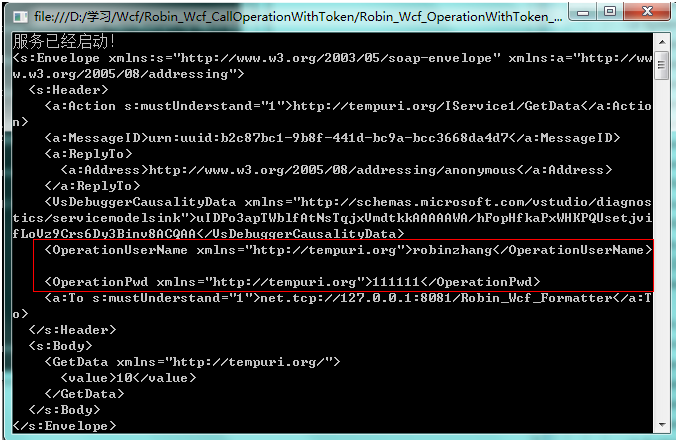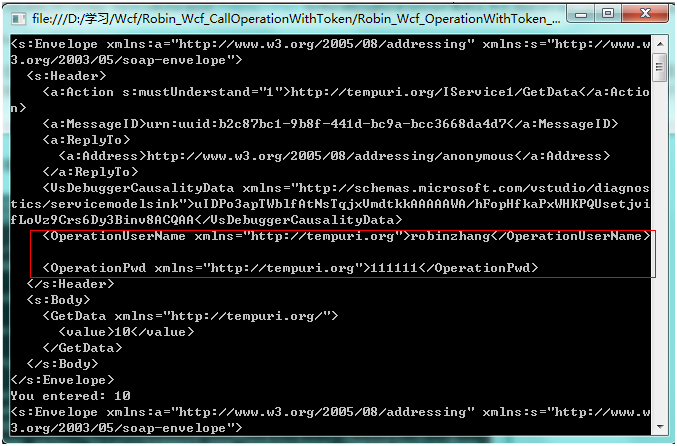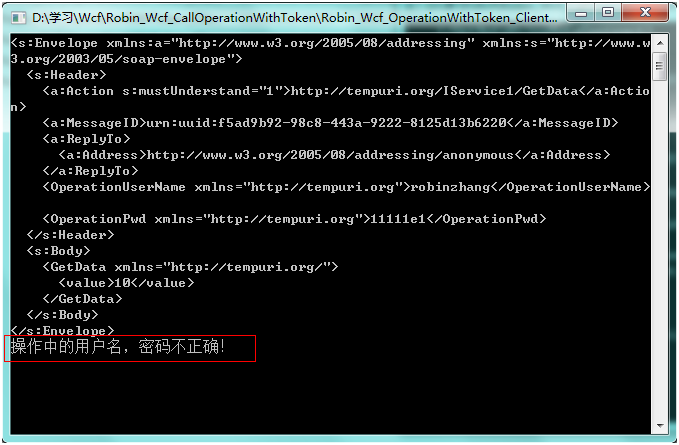上文WCF进阶:将消息正文Base64编码中介绍了实现自定义MessageInspector来记录消息和实现自定义Formatter来改写消息,本文介绍一下在WCF中使用SoapHeader进行验证的两种实现方法,同时再次复习自定义Inspector和自定义EndpointBehavior。
在Xml Web Service中能将用户的身份信息如用户名,密码添加到SoapHeader中,从而实现服务调用的身份验证,这种做法是沿用了Http中用户名,密码 身份验证,是我们最乐于接受的。而在WCF中因为提供了非常健壮的安全机制,但实现起来真是不够简单。对于多数应用情景来讲,有点大炮打蚊子的感觉。因此 好多人在网上询问在WCF中如何象XMl Web Service一样使用SoapHeader来完成用户名,密码身份验证。传统的办法是通过在服务的操作中从 OperationContext.Current.IncomingMessageHeaders来获取Header中的内容,而在客户端在 OperationContext.Current.OutgoingMessageHeaders中添加MessageHeader。下面的代码片段简 要的介绍了这种实现:
在服务端的一个Operation中
public string GetData(int value)
{
System.Text.Encoding encoding = System.Text.Encoding.GetEncoding("utf-8");
string username = "";
string pwd = "";
int index = OperationContext.Current.IncomingMessageHeaders.FindHeader("username", "http://tempuri.org");
if (index >= 0)
{
username = OperationContext.Current.IncomingMessageHeaders.GetHeader<string>(index).ToString();
}
index = OperationContext.Current.IncomingMessageHeaders.FindHeader("pwd", "http://tempuri.org");
if (index >= 0)
{
pwd = OperationContext.Current.IncomingMessageHeaders.GetHeader<string>(index).ToString();
}
return string.Format("You entered: {0}", value);
}
在客户端调代码如下:
Robin_Wcf_Formatter_Svc.Service1Client svc = new Robin_Wcf_Formatter_Svc.Service1Client();
using (OperationContextScope scope = new OperationContextScope(svc.InnerChannel))
{
MessageHeader header = MessageHeader.CreateHeader("username", "http://tempuri.org", "robinzhang");
OperationContext.Current.OutgoingMessageHeaders.Add(header);
header = MessageHeader.CreateHeader("pwd", "http://tempuri.org", "robinzhang");
OperationContext.Current.OutgoingMessageHeaders.Add(header);
string res = svc.GetData(10);
}
通过上边的代码实现,已经能在WCF中使用SoapHeader来传递身份信息了。但这种方式需要在每次客户端调用和每个服务操作中都增加类似代码 片断。比较麻烦。多数情况下,我们的服务开发好之后,往往只开放给固定的用户用于消费,如果我们的服务的实例模式为PerCall,也就是不保存会话,同 时我们又希望能验证调用者的身份信息,我们需要在每个Operation的消息中增加SoapHeader来附加身份信息。这样服务即可保证每一个操作都 不被非法调用。阅读完上篇文章,已经了解到通过MessageInspector能拦截消息用于记录或者修改,如果在拦截到消息之后,在消息中增加 MessageHeader便可以实现上述需求。为此我们实现了一个实现IClientMessageInspector, IDispatchMessageInspector, IEndpointBehavior三个接口的类,这样该类就承担了两种角色,自定义MessageInspector,自定义 EndpointBehavior。这个类的代码如下:
using System;
using System.Collections.Generic;
using System.Linq;
using System.Text;
using System.ServiceModel.Dispatcher;
using System.ServiceModel.Description;
using System.ServiceModel.Channels;
using System.ServiceModel;
namespace RobinLib
{
public class AttachUserNamePasswordBehavior : IClientMessageInspector, IDispatchMessageInspector, IEndpointBehavior
{
private static string UserName = System.Configuration.ConfigurationSettings.AppSettings["username"];
private static string Password = System.Configuration.ConfigurationSettings.AppSettings["pwd"];
public AttachUserNamePasswordBehavior()
{
}
#region IClientMessageInspector 成员
public void AfterReceiveReply(ref System.ServiceModel.Channels.Message reply, object correlationState)
{
}
public object BeforeSendRequest(ref System.ServiceModel.Channels.Message request, System.ServiceModel.IClientChannel channel)
{
MessageHeader userNameHeader = MessageHeader.CreateHeader("OperationUserName", "http://tempuri.org", UserName, false, "");
MessageHeader pwdNameHeader = MessageHeader.CreateHeader("OperationPwd", "http://tempuri.org", Password, false, "");
request.Headers.Add(userNameHeader);
request.Headers.Add(pwdNameHeader);
Console.WriteLine(request);
return null;
}
#endregion
#region IDispatchMessageInspector 成员
string GetHeaderValue(string key)
{
int index = OperationContext.Current.IncomingMessageHeaders.FindHeader(key, "http://tempuri.org");
if (index >= 0)
{
return OperationContext.Current.IncomingMessageHeaders.GetHeader<string>(index).ToString();
}
return null;
}
public object AfterReceiveRequest(ref System.ServiceModel.Channels.Message request, System.ServiceModel.IClientChannel channel, System.ServiceModel.InstanceContext instanceContext)
{
Console.WriteLine(request);
string username = GetHeaderValue("OperationUserName");
string pwd = GetHeaderValue("OperationPwd");
if (username == "robinzhang" && pwd == "111111")
{
}
else
{
throw new Exception("操作中的用户名,密码不正确!");
}
return null;
}
public void BeforeSendReply(ref System.ServiceModel.Channels.Message reply, object correlationState)
{
}
#endregion
#region IEndpointBehavior 成员
public void AddBindingParameters(ServiceEndpoint endpoint, System.ServiceModel.Channels.BindingParameterCollection bindingParameters)
{
}
public void ApplyClientBehavior(ServiceEndpoint endpoint, System.ServiceModel.Dispatcher.ClientRuntime clientRuntime)
{
clientRuntime.MessageInspectors.Add(new AttachUserNamePasswordBehavior());
}
public void ApplyDispatchBehavior(ServiceEndpoint endpoint, System.ServiceModel.Dispatcher.EndpointDispatcher endpointDispatcher)
{
endpointDispatcher.DispatchRuntime.MessageInspectors.Add(new AttachUserNamePasswordBehavior());
}
public void Validate(ServiceEndpoint endpoint)
{
}
#endregion
}
}
象上文一样,将自定义的EndpointBehavior通过代码方式应用到Host和Proxy中
服务宿主程序
using System;
using System.Collections.Generic;
using System.Linq;
using System.Text;
using System.ServiceModel;
namespace Robin_Wcf_OperationWithToken_Host
{
public class Program
{
static void Main(string[] args)
{
//服务地址
Uri baseAddress = new Uri("net.tcp://127.0.0.1:8081/Robin_Wcf_Formatter");
ServiceHost host = new ServiceHost(typeof(Robin_Wcf_OperationWithToken_SvcLib.Service1), new Uri[] { baseAddress });
//服务绑定
NetTcpBinding bind = new NetTcpBinding();
host.AddServiceEndpoint(typeof(Robin_Wcf_OperationWithToken_SvcLib.IService1), bind, "");
if (host.Description.Behaviors.Find<System.ServiceModel.Description.ServiceMetadataBehavior>() == null)
{
System.ServiceModel.Description.ServiceMetadataBehavior svcMetaBehavior = new System.ServiceModel.Description.ServiceMetadataBehavior();
svcMetaBehavior.HttpGetEnabled = true;
svcMetaBehavior.HttpGetUrl = new Uri("http://127.0.0.1:8001/Mex");
host.Description.Behaviors.Add(svcMetaBehavior);
}
host.Opened += new EventHandler(delegate(object obj, EventArgs e)
{
Console.WriteLine("服务已经启动!");
});
foreach (var sep in host.Description.Endpoints)
{
sep.Behaviors.Add(new RobinLib.AttachUserNamePasswordBehavior());
}
host.Open();
Console.Read();
}
}
}
客户端代理
[System.Diagnostics.DebuggerStepThroughAttribute()]
[System.CodeDom.Compiler.GeneratedCodeAttribute("System.ServiceModel", "3.0.0.0")]
public partial class Service1Client : System.ServiceModel.ClientBase<Robin_Wcf_OperationWithToken_ClientApp.ServiceReference1.IService1>, Robin_Wcf_OperationWithToken_ClientApp.ServiceReference1.IService1
{
public Service1Client()
{
base.Endpoint.Behaviors.Add(new RobinLib.AttachUserNamePasswordBehavior());
}
public Service1Client(string endpointConfigurationName) :
base(endpointConfigurationName)
{
base.Endpoint.Behaviors.Add(new RobinLib.AttachUserNamePasswordBehavior());
}
public Service1Client(string endpointConfigurationName, string remoteAddress) :
base(endpointConfigurationName, remoteAddress)
{
base.Endpoint.Behaviors.Add(new RobinLib.AttachUserNamePasswordBehavior());
}
public Service1Client(string endpointConfigurationName, System.ServiceModel.EndpointAddress remoteAddress) :
base(endpointConfigurationName, remoteAddress)
{
base.Endpoint.Behaviors.Add(new RobinLib.AttachUserNamePasswordBehavior());
}
public Service1Client(System.ServiceModel.Channels.Binding binding, System.ServiceModel.EndpointAddress remoteAddress) :
base(binding, remoteAddress)
{
base.Endpoint.Behaviors.Add(new RobinLib.AttachUserNamePasswordBehavior());
}
public string GetData(int value)
{
return base.Channel.GetData(value);
}
public Robin_Wcf_OperationWithToken_ClientApp.ServiceReference1.CompositeType GetDataUsingDataContract(Robin_Wcf_OperationWithToken_ClientApp.ServiceReference1.CompositeType composite)
{
return base.Channel.GetDataUsingDataContract(composite);
}
到此,代码基本实现了,在正式应用的时候,我们只需要为每个客户端创建独立的用户名,密码对,然后将这个信息通过一些渠道告诉服务消费者,服务消费 者需要将用户名,密码放到Web.Config中的AppSettings中。而且在正式应用的时候,需要将放置到MessageHeader中的用户 名,密码进行加密,而不是明文传输。这样这套机制就能用于生产啦。
通过这种办法,我们能为每个操作都设定身份验证,同时不需要更改Operation函数内容和客户端调用方式,我们来看一下运行结果:
用户,密码正确情况下的调用
服务器端:

客户端:

如果用户名,密码不匹配,服务能正常运行,但客户端会遇到异常
